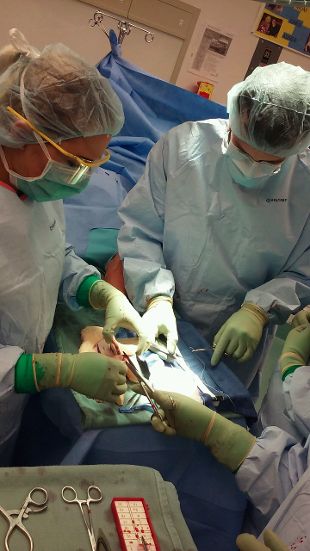
A bus full of church members collides on I-81 with a truck carrying anhydrous ammonia. A cloud of the deadly gas is released in the air. There are multiple injuries from the crash and respiratory problems associated with the ammonia cloud. Agitated spouses demanding answers threaten to disrupt the speed with which their loved ones can be care for and must be calmed down.
Doctors, nurses, therapists, physician’s assistants and other health care professionals work together in a hectic emergency department, and in operating rooms. Real life? It can be but in this case it was the 10th annual Interprofessional Education Simulation at Jefferson College of Health Sciences. Volunteer “actors” in realistic makeup – following a script devised for their injuries – and several posing as concerned spouses lend a greater air of authenticity.
The mid-April exercise brought together students from JCHS in various disciplines, Virginia Tech Carilion School of Medicine students and those in the nursing program at Radford University, which includes classes taken at Jefferson College. (Within the next two years JCHS will become a Radford school.)
Kimberly Whiter is director of the Interprofessional Education program at Jefferson College. She worked with a team for about a year to come up with the latest scenario, an exercise designed to help students gain more “real world” experience in dealing with others in the field they will have to work with after graduation. “Nearly 300 students in total are participating,” said Whiter.
She adds that interprofessional education specifically in health care is about more than just being good teammates. “It’s recognizing this is what I do for health care; I understand what you do for health care and this is how we do that together. Sometimes that means our jobs overlap, sometimes I have things that you can’t do and sometimes you have things that I can’t do. We need to understand the dynamic about the care that we give.”
Whiter says the typical inpatient will see 17 health care professionals during their stay: “gone are the days of seeing a doctor and a nurse and that’s it.” Those taking part were senior level students at JCHS and yes some were “very nervous. They are up on their toes. They are surprised to come in and see that someone is interacting with them.” Facilitators from Jefferson College supervised (and assessed) to make sure the simulation moved along smoothly as the learning tool it was designed to be.
Ankita Sridhar is a third year medical student at the nearby Virginia Tech Carilion campus. “This is how it’s actually going to be like when we are in the trauma bay. As med students we do labs during our rotation but that’s just with other med students. It’s great being able to actually work with a team. You get a good idea of what your role is –what are the nurse’s roles, what are the PA’s roles. It helps you play together as team. It’s really cool to really play together here … in a controlled environment.”
Abigail Kusi, a respiratory therapy student (helpful with the fictional ammonia cloud) says with graduation around the corner for her in May the realistic emergency department scenarios are helpful. “They help us [to learn] how to work with other professions. I was nervous initially but I calmed down after a while and it was a good activity for me. We used our critical thinking.”
Brittany Hodges is a senior nursing student at Jefferson College. “I kind of kept the case going,” says Hodges of one scenario she facilitated. “I had all the information but wasn’t supposed to give it to them unless they asked for it. I [was supposed] to lead and guide them.” The exercise was one step closer to the real world for these health care students.
Gene Marrano


